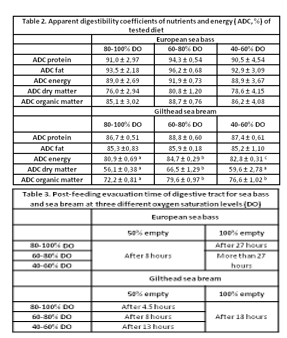EFFECT OF DIFFERENT DISSOLVED OXYGEN CONCENTRATIONS ON DIGESTIBILITY AND GASTRIC EVACUATION RATES OF EUROPEAN SEA BASS Dicentrarchus labrax AND GILTHEAD SEA BREAM Sparus aurata
Introduction
Low levels of dissolved oxygen in farm water and high temperatures are potential stressors parameters that affect fish growth, digestion, behavior and health (Petersen & Gamperl, 2010). Changes in oxygen levels can affect the morphology of the gut and the ability to digest nutrients (Tran-Ngoc et al., 2016). Under the same rearing and diets conditions, understanding the relationship between digestion and gastric evacuation can help to estimate the time of appetite return (Riche et al., 2004). Information of how dissolved oxygen could affect the feed digestibility and the gastric evacuation rates of fish are useful for feeding frequency estimation aiming at more efficient nutrient utilization and establishing an appropriate feeding protocol. The aim of this work was to measure feed digestibility and gastric evacuation rates of sea bream and sea bass in 3 different dissolved oxygen rages.
Materials and Methods
Two digestibility and gastric evacuation rates trials were conducted at the Aqualabs facilities of the Institute of Marine Biology, Biotechnology and Aquaculture (IMBBC) of the Hellenic Centre for Marine Research (Heraklion, Greece), both for European sea bass and Gilthead sea bream. Fifteen fish (250 gr initial body weight) were placed in 3 closed recirculation systems each consisting of tanks of 500 L capacity under fully controlled oxygen, light and water flow conditions. A different level of oxygen saturation in the rearing water was applied to each closed recirculation system (80-100% DO, 60-80 DO and 40-60% DO) at 26.5 oC water temperature. The fish were hand-fed a commercial diet (Table 1) to satiation after additing of 1% celite® as an inert marker in the feeds, three times daily. Feed and feaces proximate compositions were determined according to (AOAC, 1990). Apparent digestibility coefficients of nutrients and energy of the diet were calculated using the following formulas: ADC = 1–(F/Dx Dm/Fm); where: D=% nutrient (or MJ/kg gross energy) of diet; F=% nutrient (or MJ/kg gross energy) of feaces; Dm=% digestion marker (AIA) of diet; Fm=% digestion marker (AIA) of feaces. For the gastric evacuation rates determination, after feeding a single meal, 3 fish were killed every 3h over a period of 24 h and the digestive tract contents were collected and the dry weight were measured.
Results and Discussion
Apparent digestibility coefficient values of tested diet under different oxygen saturation regime for sea bass and sea bream are showed in Table 2. Apparent digestibilities of nutrients and energy for sea bass were not affected by the oxygen level (P>0.05). Crude protein and fat digestibility (86-89% and 85%, respectively) for sea bream were not significantly (P>0.05) different among three dissolved oxygen levels. Energy, Dry matter and organic matter were more digestible (P<0.05) in the group with 60-80% DO. Energy and dry matter digestibility showed the lowest values in the 80-100% DO group, whereas organic matter digestibility did not differ between the 60-80% and 40-60% DO groups (P>0.05). Digestibility coefficients values were high for all oxygen levels for both species comparing with previous studies (Ballester‐Moltó et al., 2017). Gastric evacuation times are summarized in Table 3. Oxygen saturation had a significant effect on the rate of digestion of the digestive system for both species. The evacuation rate of the digestive system, influenced by the different oxygen levels in sea bream, appeared to modify the feed transit rate and its presence in the intestine. No differences were found for sea bass ADCs under different oxygen levels in contrast to the different evacuation rates among groups. The gastric evacuation rates for the two species were significantly different (P<0.05), with the sea bream emptying its digestive tract completely after 18 hours while the seabass after 27 hours for the high DO group (80-100%) or more than 27 hours for 60-80% and 40-60% DO groups.
Acknowledgments
The program is co-funded by the European Maritime and Fisheries Fund in Greece (EMFF OP) and the Hellenic Republic via the Operational Programme "Fisheries and Maritime 2014-2020" (EPALTH 2014-2020). Program MIS 5030044.
References
AOAC. 1990. Official methods of analysis. Arlington, Virginia, USA.
Ballester‐Moltó, M., Follana‐Berná, G., Sanchez‐Jerez, P., &Aguado‐Giménez, F. (2017). Total nitrogen, carbon and phosphorus digestibility in gilthead seabream (Sparus aurata) and European seabass (Dicentrarchus labrax) fed with conventional and organic commercial feeds: implications for particulate waste production. Aquaculture Research, 48(7), 3450-3463.
Petersen, L. H., & Gamperl, A. K. (2010). Effect of acute and chronic hypoxia on the swimming performance, metabolic capacity and cardiac function of Atlantic cod (Gadus morhua). Journal of Experimental Biology, 213(5), 808-819.
Riche, M., Haley, D. I., Oetker, M., Garbrecht, S., &Garling, D. L. (2004). Effect of feeding frequency on gastric evacuation and the return of appetite in tilapia Oreochromis niloticus (L.). Aquaculture, 234(1-4), 657-673.
Tran-Ngoc, K. T., Dinh, N. T., Nguyen, T. H., Roem, A. J., Schrama, J. W., &Verreth, J. A. (2016). Interaction between dissolved oxygen concentration and diet composition on growth, digestibility and intestinal health of Nile tilapia (Oreochromis niloticus). Aquaculture, 462, 101-108.

